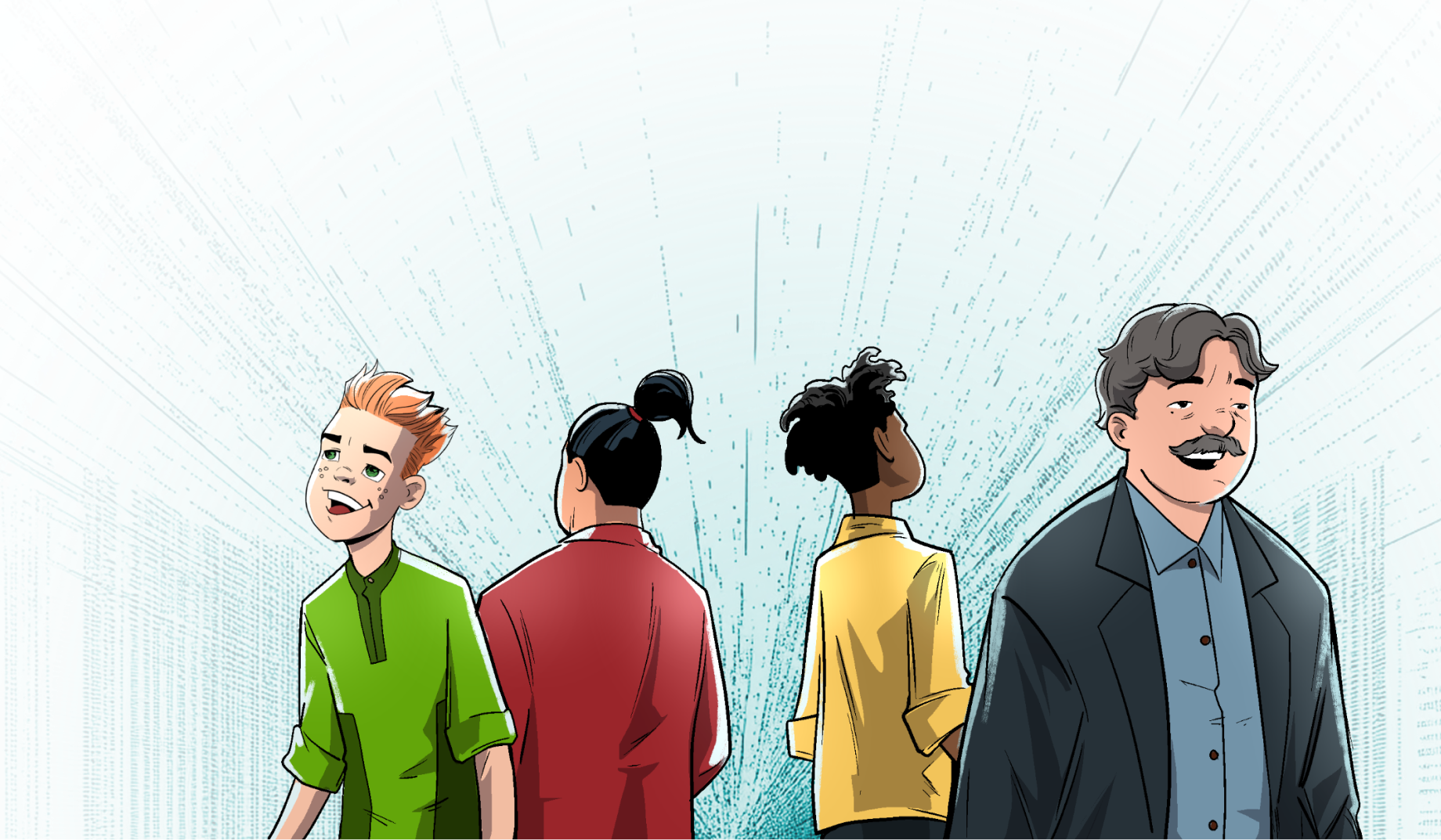Below, explore some of the forces of change that our research found to be particularly important when considering assessment trends.
 Teacher Troubles
Teacher Troubles
The formal K-12 teacher workforce will continue to erode and will become increasingly misaligned with the needs and realities of the classroom.
The teacher workforce will continue to shrink, with more people leaving than entering the profession. State departments of education and school districts will continue implementing various strategies to bolster numbers.[footnote=2]For example, they might grant temporary teacher licenses, reduce the time needed to earn a certification or offer financial incentives for becoming a teacher.[footnote=3]Furthermore, teacher preparation programs will continue to lag in adapting their pre-service training and ongoing professional development offerings to fit a complex and changing educational landscape that will require new kinds of pedagogical approaches, assessment literacies and student-teacher relationships.[footnote=4][footnote=5]The extent to which teachers have and deserve full professional status will continue to be debated.
Balingit, M. (2023, August 24). Teacher Shortages have Gotten Worse. Here’s how Schools are Coping. Retrieved from The Washington Post: https://www.washingtonpost.com/education/2023/08/24/teacher-shortages-pipeline-college-licenses/
Greene, T. (2024, January 10). From Policy to Action: How 7 States Strengthened Their K-12 Teacher Pipelines in 2023. Retrieved from ExcelinEd in Action: https://excelinedinaction.org/2024/01/10/from-policy-to-action-how-7-states-strengthened-their-k-12-teacher-pipelines-in-2023/
Will, M. (2022, March 22). Fewer People Are Getting Teacher Degrees. Prep Programs Sound the Alarm. Retrieved from EducationWeek: https://www.edweek.org/teaching-learning/fewer-people-are-getting-teacher-degrees-prep-programs-sound-the-alarm/2022/03
Knox, L. (2022, August 29). Teacher Education Programs Desperately Seek Students. Retrieved from Inside Higher Ed: https://www.insidehighered.com/news/2022/08/29/teacher-shortage-tied-education-programs-enrollment-drop
 Learning Flexibility
Learning Flexibility
Increasing adoption of student-centered learning models will enable more flexibility in learning environments.
Continued interest in addressing learners’ needs and engaging them will drive the increasing adoption of student-centered learning models, including personalized learning, competency-based learning and project-based learning.[footnote=6] This shift will create an opening to include more culturally relevant knowledge, community-based curricula and liberatory practices in K-12 education. It will also help counter rigid assessment practices and systems that narrow the curriculum along white-centered values and standards.[footnote=7][footnote=8]
Brixey, M., & Miller, S. (2023, August 1). 2023 Legislative Session Recap. Retrieved from KnowledgeWorks: https://knowledgeworks.org/resources/legislative-session-recap/
Stanford, L. (2023, May1). Every State Now Lets Schools Measure Students’ Success Based on Mastery, Not Seat Time. Retrieved from EducationWeek: https://www.edweek.org/policy-politics/every-state-now-lets-schools-measure-students-success-based-on-mastery-not-seat-time/2023/05
KnowledgeWorks (2023, October 3). Beyond the Horizon: Blazing a Trail Toward Learner-Centered School Quality Systems. Retrieved from KnowledgeWorks: https://knowledgeworks.org/resources/beyond-horizon-learner-centered-quality/
 Cognitive Contexts
Cognitive Contexts
The learning science field will continue to expand its scope to include diverse social, emotional, economic and environmental determinants of cognition.
Learning science is increasingly examining learners’ broader contexts and histories to understand their impact on cognition and their implications for the classroom.[footnote=9] In particular, learning scientists are increasingly exploring how adverse childhood experiences (ACEs), such as experiencing and/or witnessing abuse, neglect, violence, addiction, incarceration or abandonment, create trauma and impact the brain’s learning processes, especially working memory and long-term memory.[footnote=10] Insights from the field of learning science will contribute to the development of additional trauma-informed pedagogies and classroom practices.[footnote=11]
Darling-Hammond, L., Flook, L., Cook-Harvey, C., Barron, B., & Osher, D. (2020). Implications for Educational Practice of the Science of Learning and Development. Applied Developmental Science, 24(2), 97–140. Retrieved from: https://doi.org/10.1080/10888691.2018.1537791
Weems CF., Russell JD., Herringa RJ., & Carrion VG. (2021, February 1). Translating the Neuroscience of Adverse Childhood Experiences to Inform Policy and Foster Population Level Resilience. Retrieved from Am Psychol: https://www.ncbi.nlm.nih.gov/pmc/articles/PMC8186535/
Imad, M. (2021). Transcending Adversity: Trauma-Informed Educational Development. Retrieved from Pod Network: https://quod.lib.umich.edu/t/tia/17063888.0039.301?view=text;rgn=main
 New Organizing Models
New Organizing Models
New models for organizing education and learning will continue to proliferate.
Communities will continue to explore new configurations for organizing education. Learning ecosystems will become a more common organizational model for the support of whole-child learning. They will be made up of cross-sector partnerships among families, caregivers, schools and community members.[footnote=12] An increase in formal and informal networks will help create and sustain change, connecting practitioners to share knowledge and expertise and provide supports.[footnote=13] Continued attempts to unbundle education from the traditional school environment will expand the choices available to students.[footnote=14] Many of these options aim to provide local communities with more agency in relation to education. Together, they promise to expand and reshape the roles and partnership opportunities among sectors, organizations, and individual actors, including caregivers and educators.
Pittman, K., & Irby, M. (2024). Too Essential to Fail: Why Our Big Bet on Public Education Needs a Bold National Response. Education Reimagined. Retrieved from: https://changingtheoddsremix.com/too-essential-to-fail/
Olson, L. (2023, April). Networks Forge a Path to School Improvement. Retrieved from The Learning Professional, A Learning Forward Journal: https://learningforward.org/journal/improving-together/networks-forge-a-path-to-school-improvement/
McClennen, N. (2024). Unbundled: Designing Personalized Pathways for Every Learner. Retrieved from Getting Smart: https://www.gettingsmart.com/whitepaper/unbundled-learning/
 Postsecondary Shifts
Postsecondary Shifts
Diversifying postsecondary options will require more awareness and student agency.
Postsecondary education and training options will diversify as the cost of college continues to increase,[footnote=15] postsecondary institutions explore new organizational structures, online degree options grow and alternative credentialing opportunities expand. Enrollment in two- and four-year institutions will continue to decline, prompting more mergers, acquisitions and closures.[footnote=16] At the same time, online and in-person programs for certifying job-related knowledge and skills, such as project management, data analysis, software development and paraprofessional health skills, will proliferate, becoming increasingly accepted by employers.[footnote=17] High schools’ career-technical education pathways will become more robust, with community organizations and employers partnering to introduce students to career options and help them develop relevant job skills.[footnote=18] The growing variety of options for transitioning from high school to postsecondary education and training, and eventually to a career, will require more individual student awareness and agency.
Hanson, M. (2023, August 13). College Tuition Inflation Rate. Retrieved from Education Data Initiative:
https://educationdata.org/college-tuition-inflation-rate
O’Connell-Domenech, A. (2024, January 10). College enrollment could take a big hit in 2025. Here’s why. Retrieved from The Hill: https://thehill.com/changing-america/enrichment/education/4398533-college-enrollment-could-take-a-big-hit-in-2025-heres-why/
Fuller, J., Langer, C., & Sigelman, M. (2022, February 11). Skills-Based Hiring Is on the Rise. Retrieved from Harvard Business Review: https://hbr.org/2022/02/skills-based-hiring-is-on-the-rise
Koehler, L., Hinds, H., & Lee, N. (2023, March). Expanding Opportunity: How States Can Accelerate the Use of Career Pathways Programs to Help Young People Access Meaningful Careers. Bellwether. Retrieved from: https://bellwether.org/wp-content/uploads/2023/03/ExpandingOpportunity_Bellwether_March2023.pdf
 Emerging Economy
Emerging Economy
Job reconfiguration due to increasing automation will disproportionately impact underserved communities.
Increasing use of automation will reconfigure jobs, changing the workforce landscape, nearly eliminating routine work and support jobs.[footnote=19] Reconfigured jobs will include more gig and contingent work in place of full-time, long-tenure employment.[footnote=20] While efforts to spur employment are in the works (for example technology and innovation hubs for 31 communities across the country), they may not be accessible to all without appropriate education, training, and skill development.[footnote=22] Employment in such zones will require enhanced skills in data analysis, STEM fields, complex decision-making, the use of digital technologies and the application of software tools. These are the areas with the greatest disparities in student representation, in school and in the workforce. [footnote=23] Without access to training and education to meet these emerging skill requirements, efforts to boost employment in the emerging economy may not reach everyone.
Broady, K., Booth Bell. D., Barr, A., & Perry, R. (2023, February 27). Retrieved from the Federal Bank of Chicago: https://doi.org/10.21033/wp-2023-06
Hussein, F. (2023, September 8). Online gig work is growing rapidly, but workers lack job protections, a World Bank report says. Retrieved from the Associated Press: https://apnews.com/article/online-gig-workers-labor-employment-world-bank-40b81a789fd5f0fb366e83f0223d832f
Superville, D. (2023, October 23). Biden names technology hubs for 32 states and Puerto Rico to help the industry and create jobs. Retrieved from the Associated Press: https://apnews.com/article/biden-raimondo-tech-hubs-innovation-jobs-205ef4710451f2d37595739056c648ae
Jeffery, A., & Jimenz, L. (2021, April 22). Preparing Students of Color for the Future Workforce. Retrieved from the Center for American Progress: https://www.americanprogress.org/article/preparing-students-color-future-workforce/
Fry, R, Kennedy, B., & Funk, C. (2021, April 1). STEM Jobs See Uneven Progress in Increasing Gender, Racial and Ethnic Diversity. Retrieved from Pew Research Center: https://www.pewresearch.org/science/2021/04/01/stem-jobs-see-uneven-progress-in-increasing-gender-racial-and-ethnic-diversity/
 Ideological Battles
Ideological Battles
Intensifying political polarization will shape education decision making at the state and local levels.
Culture wars will continue to play out in education, shaping the experiences of learners and communities. Since 2021, state lawmakers have introduced approximately 400 bills giving parents, governments and citizens the ability to challenge and monitor what schools teach about race and gender.[footnote=24] Similarly, Pen America has recorded 4,000 instances of banned books in the first half of the 2023-2024 school year.[footnote=25] Parental rights movements will spread and intensify, with liberals and conservatives vying for control. The result will be increasing attempts to mold education along ideological lines. Decisions related to education innovation and reform will remain contentious and will risk being disconnected from classroom needs.
Gamble, J. (2023, August 24). New report finds rise in parental rights education bills has a ‘chilling effect.’ Retrieved from CNN: https://www.cnn.com/2023/08/24/us/pen-america-parental-rights-bills-concern-reaj/index.html#:~:text=Since%202021%2C%20state%20lawmakers%20have,expression%20advocacy%20group%20PEN%20America
Meehan, K., and Friedman, J. (2023, April 20). Banned in the USA: State Laws Supercharge Book Suppression in Schools. Retrieved from Pen America: https://pen.org/report/banned-in-the-usa-state-laws-supercharge-book-suppression-in-schools/
 Narrative Shift
Narrative Shift
Increasing challenges to single pathways to achievement and success will fuel thinking about multiple opportunities for success.
Criticism of the achievement gap narrative will gain support from those pushing back on the post-pandemic learning loss narrative.[footnote=26] Both narratives define achievement through reductive, summative measures that do not tell us much about what a learner can do well. In these narratives, achievement is defined narrowly, with a learner’s educational identity being overly influenced by standardized test scores and grade point averages, rather than being understood as influenced by the world around them. Growing challenges thinking about achievement in this way will open the door to more vibrant counter-narratives of achievement and success for all students.
El-Mekki, S. (2021, June 16). Pandemic Learning Loss Is Rooted in the Racial Chasm Between Educators and Students of Color. Only Teacher Diversity and a Strong Black Teacher Pipeline Can Fix It. Retrieved from the 74 Million: https://www.the74million.org/article/el-mekki-pandemic-learning-loss-is-rooted-in-the-racial-chasm-between-educators-and-students-of-color-only-teacher-diversity-and-a-strong-black-teacher-pipeline-can-fix-it/
 Climate Changes
Climate Changes
Environmental volatility will continue to disrupt underserved communities disproportionately.
Communities in underserved areas tend to be located in areas that are relatively susceptible to the impacts of extreme weather, such as flooding, fires, and energy and power blackouts. [footnote=27] The COVID-19 pandemic also highlighted the economic disparity in “essential worker” jobs. The disproportionate exposure to those in retail, health, and other service positions exposed to the viruses that will continue emerge as the impacts of climate change spread. [footnote=28] The next decade will bring increasing risks and damage from extreme weather and emergent diseases, putting underserved populations at disproportionate risk. [footnote=29] They will be more likely than other groups to experience trauma from these events, along with school disruptions and community challenges.
Maese, E., & McCarthy, J. (2023, October 30). Black, Hispanic Americans More Vulnerable to Extreme Weather. Retrieved from Gallup: https://news.gallup.com/poll/513401/black-hispanic-americans-vulnerable-extreme-weather.aspx
Schnake-Mahl, A., Lazo, M., Dureja, K., Ehtesham, N., & Usama Bilal, U. (2021, December). Racial and ethnic inequities in occupational exposure across and between US cities. SSM Population Health. Retrieved from ScienceDirect: https://www.sciencedirect.com/science/article/pii/S2352827321002342
Berberian, A., Gonzalez, D., & Cushing, L. (2022, September 9). Racial Disparities in Climate Change-Related Health Effects in the United States. Curr Environ Health Reports. Retrieved from the National Library of Medicine: https://www.ncbi.nlm.nih.gov/pmc/articles/PMC9363288/





